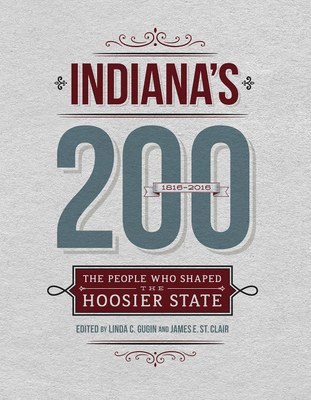
Plan your visit
One-on-One with the Editors of Indiana’s 200
November 24, 2015

Part of the Indiana Historical Society?s commemoration of the nineteenth state?s bicentennial, Indiana’s 200: The People Who Shaped the Hoosier State recognizes the people who made enduring contributions to the state of Indiana in its 200-year history.
Written by historians, scholars, biographers and independent researchers, the biographical essays in this book will enhance the public’s knowledge and appreciation of those who made a difference in the lives of Hoosiers, the country and even the world.
The editors, Linda C. Gugin and James E. St. Clair, took some time to answer questions about the book. They will sign copies at the annual Holiday Author Fair from noon to 4 p.m. on Saturday, Dec. 5.
How did you get involved with the Indiana’s 200 book project?
We were asked to take on this project by Indiana Historical Society Press editors Ray Boomhower and Kathy Breen in early 2011. We had three books previously published by the IHS Press a biography of Sherman Minton in 1997 and books on Indiana governors (2006) and Indiana Supreme Court justices (2010), both of which we edited.
How did you come up with the 200 individuals and families included in the book?
Certainly this presented a formidable challenge given the state’s rich history and multitude of worthy individuals. The task was made somewhat easier by the decision to consider only those no longer living. Still, the challenge to decide on just 200 was daunting. While some people were obvious choices such as Abraham Lincoln, Herman B Wells, and Madam C.J. Walker, we perused every issue of Traces magazine and the Indiana Magazine of History, as well as a variety of other sources to identify others to consider. We were aided considerably by close and frequent consultation with Ray and Kathy and also by suggestions from an advisory panel that included distinguished historians and others with extensive knowledge of the state?s history and of those who had made significant contributions in various fields of endeavors.
What pitfalls do you run into during the course of the book’s development?
Clearly, limiting the scope to 200 was a major challenge and we were constantly revising our list as our research continued and we discovered additional people whose significance to the state and beyond merited consideration. Finding authors to write the 200 essays, of course, was time-consuming, but again IHS Press editors and members of the advisory panel were of immense help. And we were fortunate that most people we contacted were almost immediately agreeable to accept the assignment, and in some cases agreeing to write more than one essay. Generally, authors had a year or so to write their essay or essays, and most met their deadlines. However, in a few instances, some did not and that was one pitfall we had hoped to avoid.
Do you have a favorite person featured in the book? Is there a person you would have liked to have included, but did not make the cut?
Linda: This is a very hard choice, but if forced to pick just one [favorite person] it would be Paul Emrick (1884-1965) legendary band director at Purdue University for more than 48 years. I was impressed with his creativity and his passion for marching bands. He started his long career as Purdue band director in 1905 when as a sophomore clarinetist he was elected band president and director. His innovations created college bands as we know them today. One of his major inventions was having marching bands form letters, which he introduced in 1907 when his band broke from its straight lines and formed the letter P? on the football field.
In 1920 Emrick was also responsible for the production of what is now known as the world’s largest drum, which still today is part of the Purdue band’s halftime performances. Emrick put Purdue’s band on the national map in 1935 with a performance at the first-night football game in the Big Ten. At the halftime, with the lights turned down, spectators were treated to a spectacular show. As the baton of the drum major dripped fire behind him the uniforms and instruments of the band members sparkled with tiny lights. Spotlights beamed from the world largest drum. The CBS radio announcer declared this is a real American band, and ever since it has been called the Purdue All-American marching band. Besides honing the musical skills of band members, Emrick had a positive influence on their lives. Popcorn King Orville Redenbacher said he learned to toot his own horn in the band, and Neil Armstrong called Emrick an icon, easily the most colorful of all my professors.
I would like to have included Lucy Taggart (1880-1960) an accomplished artist and the daughter of political boss Thomas Taggart. She was a prominent figure in the life of the Hoosier state for over half a century. I loved her paintings. She was especially known for her portraits, but also for her landscapes and still lifes. Her works were exhibited in eastern galleries such as the Pennsylvania Academy of Fine arts in Pennsylvania and for the National Association of Women Painters and Sculptors at the Colony Club, a women’s organization in New York. Her work was also exhibited five times in the Hoosier Salon. She taught painting classes at the Herron School of Art and served on the Board of the school for 44 years.
Jim: My choice [for favorite person] is Charles Conn, a person previously unknown to me. He was not a native Hoosier, but settled with his family in 1848 in Elkhart. His fascinating and productive life included the following: decorated Civil War veteran; entrepreneur who started a musical instrument manufacturing business, which lives on today as a subsidiary of Steinway Musical Instruments; mayor of Elkhart; congressman; founder of the Elkhart Truth newspaper; and visionary business owner who introduced a widely admired profit-sharing plan for his employees in 1891.
Many were hard to eliminate and one in particular [I would like to have included] was Doctor Ryland T. Brown (1807-1890), the state’s first geologist, who traveled the entire state locating stone quarries and coalfields. He was appointed chemist-in-chief for the U.S. Department of Agriculture in 1872 and left to become chair of physiology at the Indiana Medical College.










